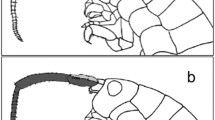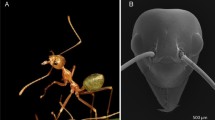Summary
-
1.
Providing the nest with vegetable food,Lethrus performs repeated excursions of about l m from the hole and returns home.
-
2.
Homing by the straight line,Lethrus walks in compass direction toward the nest; the distance traveled is equal to the estimated distance to the hole, and in a case of faultLethrus begins the circling search.Lethrus is able to integrate over the complex path.
-
3.
Lethrus sets direction relative to celestial cues: the sun and the polarized skylight.
-
4.
Lethrus has two photoreceptor systems: the green-sensitive and UV-sensitive one; only an ultraviolet polarization pattern is used for polarotaxis.
-
5.
The eye ofLethrus evolved from the superpositional prototype; it is adapted to diurnal vision by shortening of the clear zone and by thickening of the light-guiding tracts from the cone to the rhabdom.
-
6.
Lethrus is different from other Lamellicorns possessing a typical multilobed rhabdom in thatLethrus has a crustacean-type rhabdom. It is assumed that this specialization of rhabdom provides the perfect analysis of polarized light and polarotaxis.
-
7.
The complex orientational and nest behavior ofLethrus is not accompanied by enlargement of the brain and its presumed associative centres, the mushroom bodies. Among several scarabaeid beetles of comparable size (Amphimallon solstitialis, Geotrupes stercorosus)Lethrus apterus gains the first place in behavioral complexity but the last in number of sensilla on the antennal dumb, number of ommatidia, and the volume of mushroom globuli.
Similar content being viewed by others
References
Berestyńska-Wilczek, M.: Observations on sensitivity in spiders, Pirata piraticus. (In Polish). Acta biol. Cracoviensica. Ser. zool.5, 263–277 (1962)
Birukow, G.: Photogeomenotaxis beiGeotrupes silvaticus Panz. und ihre zentralnervöse Koordination. Z. vergl. Physiol.36, 176–211 (1954)
Collett, T.S., Land, M.F.: Visual spatial memory in a hoverfly. J. comp. Physiol.100, 59–84 (1975)
Couturier, A., Robert, P.: Recherches sur la faculté d'orientation du hanneton commun (Melolontha melolontha L.). C.R. Acad. Sci.245, 2399–2401 (1957)
Daumer, K., Jander, R., Waterman, T.: Orientation of the ghost crabOcypode in polarized light. Z. vergl. Physiol.47, 56–76 (1963)
Duelli, P.: A fovea for e-vector orientation in the eye ofCataglyphis bicolor (Formicidae, Hymenoptera). J. comp. Physiol.102, 43–56 (1975)
Edrich, W., Heiversen, O.v.: Polarized light orientation of the honey bee: the minimum visual angle. J. comp. Physiol.109, 309–314 (1976)
Fabre, J.-H.: Souvenirs entomologiques. Etudes sur l'instinct et les moeurs des insectes. 5e et 6e Sér., Paris, Librairie Delagrave (sine anno)
Frantsevich, L.I., Mokrushov, P.A., Zolotov, V.V.: Astroorientation inLethrus apterus Laxm. (Coleoptera, Scarabaeidae). (In Russian). J. gen. Biol. (USSR)36, 61–65 (1975a)
Frantsevich, L.I., Zolotov, V.V., Mokrushov, P.A.: What does a beetle see, which walks backwards? (In Russian). Priroda N2, 93–96 (1975b)
Frantsevich, L.I., Zolotov, V.V., Gribakin, F.G., Polanovski, A.D., Govardovski, V.l., Zujeva, L.V.: Polarotaxis inLethrus (Coleoptera, Scarabaeidae) in different spectral rays. (In Russian). Dokl. Acad. Nauk USSR226, 733–736 (1976)
Görner, P.: Die Orientierung der Trichterspinne nach polarisiertem Licht. Z. vergl. Physiol.45, 307–314 (1962)
Grenacher, H.: Untersuchungen über die Sehorgane der Arthropoden insbesondere der Spinnen, Insekten und Crustaceen, p. 188. Göttingen: Vandenhoeck und Ruprecht 1879
Gribakin, F.G., Govardovski, V.I.: The role of the photoreceptor membrane in photoreceptor optics. In: Photoreceptor Optics (eds. A.W. Snyder, R. Menzel), pp. 215–236. Berlin-Heidelberg-New York: Springer Verlag 1975
Hauser, G.: Physiologische und histologische Untersuchungen über das Geruchsorgan der Insekten. Z. wiss. Zool.34, 367–403 (1880)
Henton, W.W., Crawford, F.T.: The discrimination of polarized light by the tarantula. Z. vergl. Physiol.52, 26–32 (1966)
Hesse, R.: Untersuchungen über die Organe der Lichtempfindung bei niederen Thiere. 7. Von den Arthropoden-Augen. Z. wiss. Zool.70, 347–473 (1901)
Heymer, A.: Étude du comportement reproducteur et analyse des mécanismes déclencheurs innés optiques chez les Calopterygidae (Odonata, Zygoptera). Ann. Soc. entomol. France9, 219–255 (1973)
Horridge, G.A., Giddings, C.: Movement on dark-light adaptation in beetle eyes of the neuropteran type. Proc. Roy. Soc. Lond. B179, 1054, 73–85 (1971)
Horridge, G.A., Meyer-Rochow, V.B.: The eye ofAnoplognathus (Coleoptera, Scarabaeidae). Proc. Roy. Soc. Lond. B188, 1–30 (1975)
Jacobs, M.E.: Studies on territorialism and sexual selection in dragonflies. Ecology36, 566–586 (1955)
Kirschfeld, K.: Die Projektion der optischen Umwelt auf das Raster der Rhabdomere im Komplexauge vonMusca. Exp. Brain Res.3, 248–270 (1967)
Lindauer, M.: Kompaßorientierung. Ergebn. Biol.26, 158–182 (1963)
Medvedev, S.L., Nikolajev, G.V.: Description of preimaginal stages of beetlesTrox F. andLethrus Scop. (Coleoptera, Lamellicornia) with notes on their biology. (In Russian). Entomol. Rev. (USSR)51, 617–624 (1972)
Meyer-Rochow, V.B.: A crustacean-like organization of insect rhabdoms. Cytobiol.4, 241–249 (1971)
Meyer-Rochow, V.B.: The eyes ofCreophilus erythrocephalus F. andSartallus signatus Sharp. Z. Zellforsch.133, 59–86 (1972)
Meyer-Rochow, V.B.: Structure and function of the eyes of nocturnal insects. Ph. D. Thesis, Canberra, p. 300 (1973)
Nikolajev, G.V.:Lethrus jacobsoni Sem. et Medv. (Coleoptera, Scarabaeidae), pest of vine-shoots in South Kazakhstan. (In Russian). Entomol. Rev. (USSR)45, 814–818 (1966)
Palmgren, A.: A rapid method for selective silver staining of nerve fibres and nerve endings in mounted paraffin sections. Acta zool.29, 377–392 (1948)
Papi, F.: Sull'orientamento astronomico in specie del gen.Arctosa (Araneae, Lycosidae). Z. vergl. Physiol.41, 481–489 (1962)
Pardi, L., Papi, F.: Die Sonne als Kompaß beiTalitrus saltator Montagu (Amphipoda-Talitridae). Naturwissenschaften39, 262–263 (1952)
Schöne, H.: Menotaktische Orientierung nach polarisiertem und unpolarisiertem Licht bei der MangrovekrabbeGoniopsis. Z. vergl. Physiol.46, 496–514 (1963)
Schreiner, J.: Die Lebensweise und Metamorphose des Rebenschneider oder großköpfigen Zwiebelhornkäfers (Lethrus apterus Laxm.). Horae Soc. Entomol. Ross.37, 197–207 (1906)
Shaw, S.R.: Sense-cell structure and interspecies comparisons of polarized-light absorption in arthropod compound eye. Vision Res.9, 1031–1040 (1969)
Straus-Duerkheim, H.E.: Considérations générales sur l'anatomie comparée des animaux articulés. L'anatomie descriptive durMelolontha vulgaris (hanneton), p. 36. Strasbourg: F.G. Levrault (1828)
Tsuneki, K.: Return to the nest in the spider wasp (Hymenoptera). Etizenia36, 32 (969)
Winking-Nikolai, A.: Untersuchungen zur Bio-Akustik des Waldmistkäfers,Geotrupes stercorosus Scriba. Z. Tierpsychol.37, 515–541 (1975)
Wojtusiak, H., Wojtusiak, R.: Orientation by memory in socially living caterpillars (Rhopalocera). (In Polish). Kosmos3, 108–109 (1954)
Zolotov, V., Frantsevich, L.: Orientation of bees by the polarized light of a limited area of the sky. J. comp. Physiol.85, 25–36 (1973)
Author information
Authors and Affiliations
Rights and permissions
About this article
Cite this article
Frantsevich, L., Govardovski, V., Gribakin, F. et al. Astroorientation inLethrus (Coleoptera, Scarabaeidae). J. Comp. Physiol. 121, 253–271 (1977). https://doi.org/10.1007/BF00609615
Received:
Issue Date:
DOI: https://doi.org/10.1007/BF00609615




